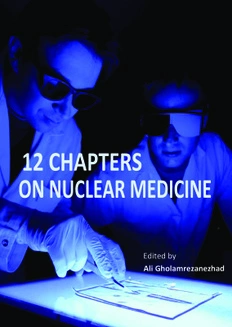
12 Chapters on Nuclear Medicine PDF
Preview 12 Chapters on Nuclear Medicine
12 CHAPTERS ON NUCLEAR MEDICINE Edited by Ali Gholamrezanezhad 1122 CCHHAAPPTTEERRSS OONN NNUUCCLLEEAARR MMEEDDIICCIINNEE Edited by Ali Gholamrezanezhad 12 Chapters on Nuclear Medicine Edited by Ali Gholamrezanezhad Copyright © 2015 Second Edition All chapters are Open Access distributed under the Creative Commons Attribution 3.0 license, which allows users to download, copy and build upon published articles even for commercial purposes, as long as the author and publisher are properly credited, which ensures maximum dissemination and a wider impact of our publications. After this work has been published by authors have the right to republish it, in whole or part, in any publication of which they are the author, and to make other personal use of the work. Any republication, referencing or personal use of the work must explicitly identify the original source. As for readers, this license allows users to download, copy and build upon published chapters even for commercial purposes, as long as the author and publisher are properly credited, which ensures maximum dissemination and a wider impact of our publications. Notice Statements and opinions expressed in the chapters are these of the individual contributors and not necessarily those of the editors or publisher. No responsibility is accepted for the accuracy of information contained in the published chapters. The publisher assumes no responsibility for any damage or injury to persons or property arising out of the use of any materials, instructions, methods or ideas contained in the book. First published December, 2011 second - 2015 ISBN-10: 953-307-802-2 ISBN-13: 978-953-307-802-1 Contents Preface IX Chapter 1 Physiologic and False Positive Pathologic Uptakes on Radioiodine Whole Body Scan 1 Byeong-Cheol Ahn Chapter 2 Internal Radiation Dosimetry: Models and Applications 25 Ernesto Amato, Alfredo Campennì, Astrid Herberg, Fabio Minutoli and Sergio Baldari Chapter 3 Medical Cyclotron 47 Reina A. Jimenez V Chapter 4 Radionuclide Infection Imaging: Conventional to Hybrid 73 Muhammad Umar Khan and Muhammad Sharjeel Usmani Chapter 5 Nuclear Medicine in Musculoskeletal Disorders: Clinical Approach 97 Noelia Medina-Gálvez and Teresa Pedraz Chapter 6 Role of the Radionuclide Metrology in Nuclear Medicine 137 Sahagia Maria Chapter 7 Breast Cancer: Radioimmunoscintigraphy and Radioimmunotherapy 165 Mojtaba Salouti and Zahra Heidari Chapter 8 Diagnosis of Dementia Using Nuclear Medicine Imaging Modalities 199 Merissa N. Zeman, Garrett M. Carpenter and Peter J. H. Scott Chapter 9 Post-Therapeutic I-131 Whole Body Scan in Patients with Differentiated Thyroid Cancer 231 Ho-Chun Song and Ari Chong VI Contents Chapter 10 Apoptosis Imaging in Diseased Myocardium 251 Junichi Taki, Hiroshi Wakabayashi, Anri Inaki, Ichiro Matsunari and Seigo Kinuya Chapter 11 Dosimetry for Beta-Emitter Radionuclides by Means of Monte Carlo Simulations 265 Pedro Pérez, Francesca Botta, Guido Pedroli and Mauro Valente Chapter 12 Skeleton System 287 Rongfu Wang Preface Nuclear Medicine is a collection of 12 chapters providing a comprehesnive overview of the nuclear medicine, with insights into both its historical and contemporary practices. I hope that readers enjoy the chapters greatly and find it informative, practical and educational in the presented discussions. I would like to convey my respects and thanks to the authors for their efforts and contribution. Collaboration has always been important in academic environment. I am very happy to see that the publication and chapters are the result of fruitful international collaboration involving more than 20 leading scientists and investigators from all over the world. I hope the "12 Chapters on Nuclear Medicine" encourage continued close cooperation and collaboration among its authors. Best regards, Ali Gholamrezanezhad, MD, FEBNM 1 Physiologic and False Positive Pathologic Uptakes on Radioiodine Whole Body Scan Byeong-Cheol Ahn Kyungpook National University School of Medicine and Hospital, South Korea 1. Introduction A radioiodine whole body scan relies on the fact that differentiated thyroid cancer is more efficient at trapping circulating radioiodine than any other tissues.(Hyer, Newbold et al. 2010) Therefore, when I-131 is administered it accumulates in the thyroid cancer tissues and a radioiodine whole body scan plays an important role in the management of patients with differentiated thyroid cancer. Uptake of iodine by the cancer is related to the expression of sodium iodide symporter (NIS), which actively transports iodide into the cancer cells. Extrathyroidal tissues, such as stomach, salivary glands and breast, are known to have the NIS expression and the organs can physiologically take up iodine.(Riesco-Eizaguirre and Santisteban 2006) On a whole body scan with diagnostic or therapeutic doses of I-131, except for the physiological radioiodine uptake in the salivary glands, stomach, gastrointestinal and urinary tracts, the lesions with radioiodine uptake can be considered as metastatic lesions in thyroid cancer patients who previously underwent total thyroidectomy. However, a variety of unusual lesions may cause a false positive result on the radioiodine whole body scan and so careful evaluation of an abnormal scan is imperative to appropriately manage patients with differentiated thyroid cancer.(Mitchell, Pratt et al. 2000; Shapiro, Rufini et al. 2000; Carlisle, Lu et al. 2003; Ahn, Lee et al. 2011) The decision to administer radioiodine treatment is mainly based on the diagnostic scan, and misinterpretation of physiological or other causes of radioiodine uptake as metastatic thyroid cancer could lead to the decision to perform unnecessary surgical removal or to administer a high dose of I-131, which results in fruitless radiation exposure. Therefore, correct interpretation of the diagnostic scan is critical for the proper management. Physiologic iodine uptake, pathologic iodine uptakes that are not related to thyroid cancer and contamination by physiologic excretion of tracer on the whole body scan are presented and discussed in this chapter. The purpose of this chapter is to make readers consider the possibility of physiologic or pathologic false positive uptake as a reason for the tracer uptake seen on the radioiodine whole body scan. 2. Iodine and the thyroid gland Iodine is an element with a high atomic number 53, it is purple in colour and it is represented by the symbol I, and the iodine is an essential component of the hormones
